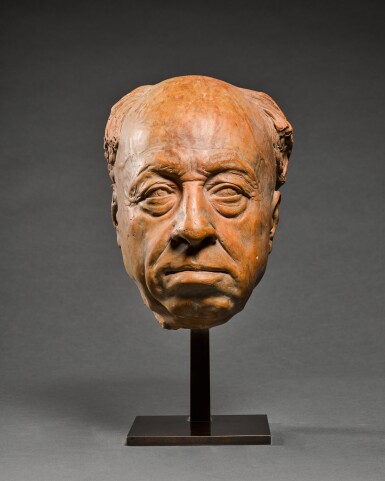Auctions
Buy Now
Collectibles & More
Books & Manuscripts
Old Master Sculpture & Works of Art
Old Master Sculpture & Works of Art

Head of a Man, called 'Il Brontolone' (Grumpy Man)
Lot Closed
December 6, 01:06 PM GMT
Estimate
15,000 - 20,000 GBP
Lot Details
Description
Italian, Florence, late 15th century
Head of a Man, called 'Il Brontolone' (Grumpy Man)
terracotta, with a modern metal stand
terracotta: 24cm., 9½in.
34cm., 13 3/8 in. overall
This remarkable terracotta portrait bust follows the famous model known as Il Brontolone or 'Grumpy Man'. The model was ascribed to Andrea della Robbia (1435-1525) or the School of Donatello (circa 1386-1466) in the 19th century and subsequently disseminated as terracotta, plaster and marble replicas. In 1998 Andrea Di Lorenzo published the marble version of Brontolone in the Museo Poldi-Pezzoli in Milan as an original work by the skilled 19th-century faker Giovannni Bastianini (Moradei-Gabbrielli collection, op. cit., pp. 30-39). Di Lorenzo posited that the model is a virtuoso fiction created by Bastianini circa 1865, inspired by the heads of old men in paintings by Filippino Lippi including his Adoration in the Uffizi and his Brancacci chapel frescoes. The author also highlights an equally remarkable Testa di Moro [sic] (Head of an African man) also form the Moradei-Gabbrielli. Di Lorenzo's argument is given credence by the provenance of the marble Brontolone in the Gabbrielli collection which can be traced to the studio of Cesare Fantacchiotti with which Bastianini had been associated.
Moskowitz, in 2013, ascribes all terracotta and marble examples to Bastianini, and notes that others were retailed by the Lelli factory, whilst plaster replicas were made by the Gipsoteca in Florence as late as the 19th century; a glazed terracotta is recorded as being in Scotland (op. cit., p. 99). A plaster by the Glasgow based plaster caster J. Giusti & Co, is in the Glasgow School of Art cast collection (inv. no. GSK/1).
The present bust thus raises an intriguing possibility: that Bastianini may have in fact based his marble on a period Renaissance model. Two recent thermoluminescence reports have dated samples from the bust to the 15th century, whilst the facture of the terracotta supports a Renaissance dating.
The Renaissance model itself share similarities with portrait heads and heads of saints by Andrea della Robbia, which explains the historic association with the Florentine sculptor. Note for example the two reliefs of administrators from the Ospidale di San Paolo in Florence. However there are links with wider 15th-century sculpture. Compare for example with the terracotta Portrait Head of a Man attributed to Benedetto da Maiano (1442-1497) in the Philadelphia Museum of Art (inv. no. 2005-147-1). Stark verism can be seen in many 15th-century Florentine portrait busts and perhaps reflected a desire to emulated the aesthetic of Republican Rome.
RELATED LITERATURE
A. di Lorenzo, Falsi da Museo: Falsi capolavori al Museo Poldi Pezzoli: itinerario didattico della mostra e schede della opere italiane, cat. Museo Poldi Pezzoli, Milan, 1998, pp. 30-39; A. F. Moskowtiz, Forging authenticity : Bastianini and the Neo-Renaissance in nineteenth century Florence, Milan, 2013, p. 99
This lot is sold with a thermoluminescence report by CIRAM dated 7 February 2020 (number: 0120-OA-103Z) which states: Ces résultats sont compatibles avec l'attribution présumée et indiquent que la tête a été fabriquée vers la fin du 15e siècle [these results are compatible with the presumed attribution and indicate that the head was made towards the end of the 15th century]. A further report by QED Laboratoire, Marseille, dated 26 December 2017 (number: QED1747:FR-0102) states: L'âge moyen de la dernière cuisson des prévèvements se situe entre 450 et 600 ans [the date of the last firing of the sample is situated between 450 and 600 years ago].